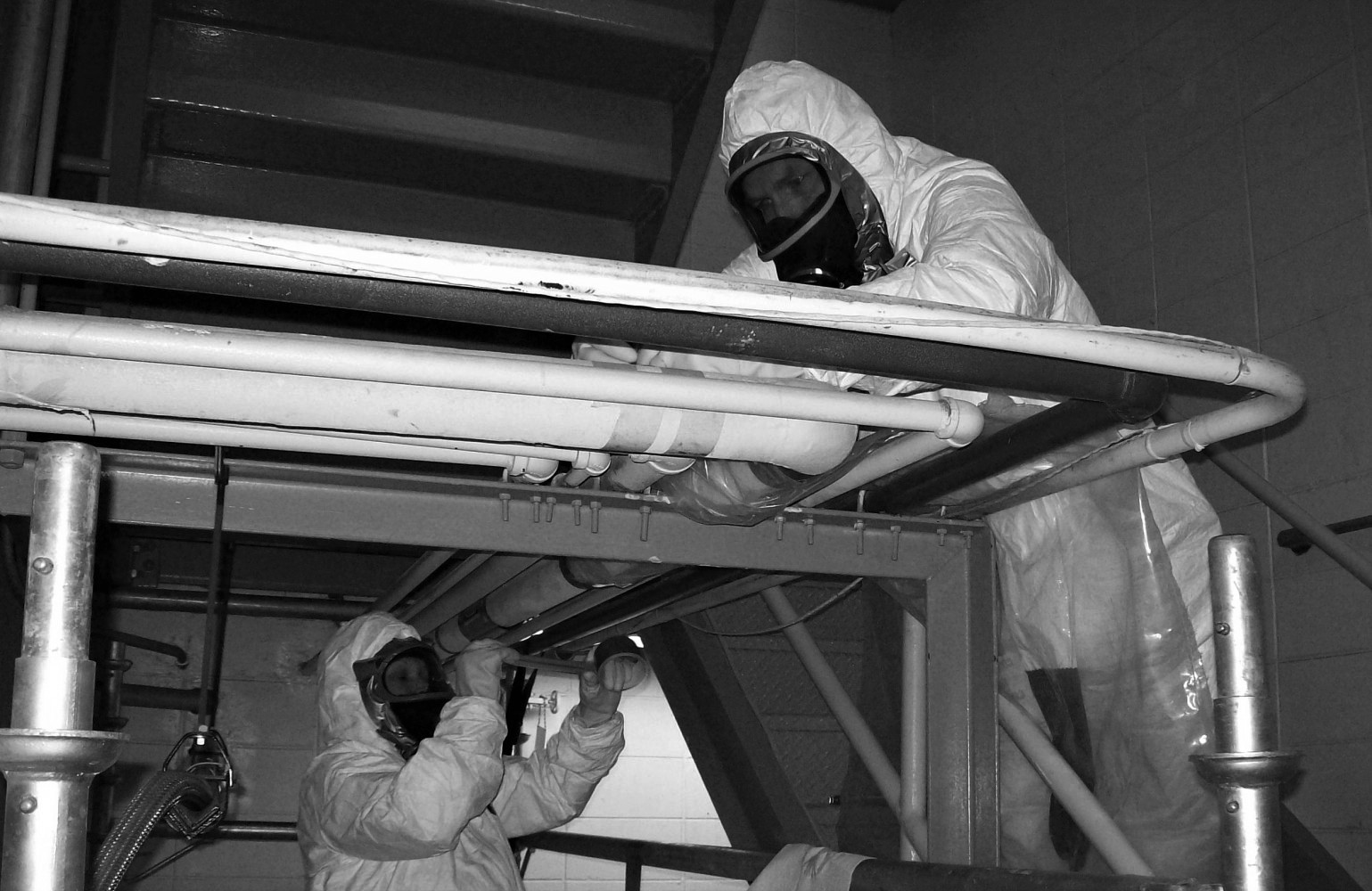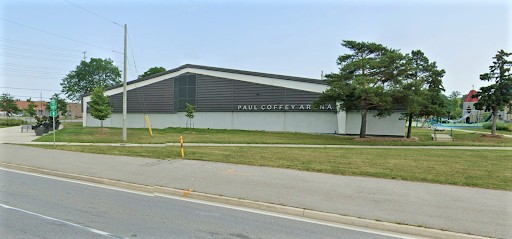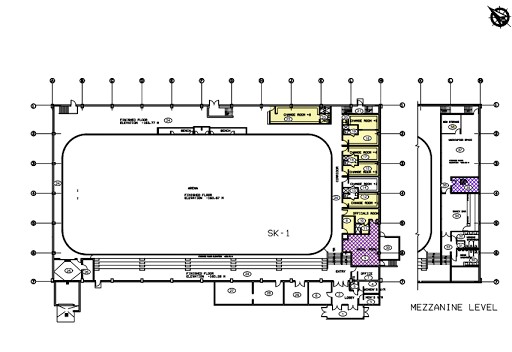
Mississauga staff admit they ignored required asbestos inspections in Malton hockey arena & other facilities
People visiting and working in two Malton buildings owned and operated by the City of Mississauga have unknowingly been in public places with asbestos in them, which the City has known about since 2009. An investigation by The Pointer reveals provincial regulations on asbestos inspections were not followed between 2012 and 2018.
The Paul Coffey Arena and the City’s public works Malton depot are among several buildings owned and operated by the City that contain asbestos. A series of inspections commissioned and conducted for Mississauga in multiple buildings during 2009 revealed the presence of the dangerous material, which is a carcinogen that can cause harm to people exposed to asbestos. The list of properties includes fire halls, libraries, arenas and the Malton depot.

The Paul Coffey Arena, formerly called the Malton Arena, contains asbestos.
(Image from Google Maps)
Inspectors from Pinchin Environmental were retained in 2009 to determine which buildings had been constructed with asbestos-containing materials. Health Canada says that, if inhaled, the fibres from asbestos can “cause cancer and other diseases”.
The material was removed — or abated — from certain locations, and remains to this day in others. Between 2012 and 2018, the City failed in its duty to annually inspect and manage asbestos, a provincial requirement that is designed to guarantee the safety of residents and workers.
A 2019 asbestos assessment of the Paul Coffey Arena and the Malton depot, part of a trove of asbestos-related documents obtained through freedom of information requests, shows the City was reminded of its duty to manage asbestos in 2019. The documents suggest City Hall was first made aware of asbestos in its buildings in 2009, with reports also completed in 2011 and 2019.
“No remedial action is required at this time,” a 2011 report by Pinchin Environmental into asbestos in the Paul Coffey Arena states, but there was supposed to be an annual inspection to ensure no immediate action was required. Eight years later, consultants reminded the City of its legislated duty to “perform a re-assessment of asbestos materials on an annual basis”.
This rule is codified under Ontario Regulation 278/05, part of the Occupational Health and Safety Act (1990). It applies to “every building in which material that may be asbestos-containing material has been used, and the owner of the building” and demands that the owner “prepare and keep on the premises a record containing the information”, as well as updating the information “at least once in each 12-month period”.
Staff working for the City of Mississauga failed to heed these rules for years.
“Annual asbestos reviews were to be completed by City staff but this did not occur from 2012 to 2018,” Raj Sheth, Mississauga’s director of facilities and property management since 2012, told The Pointer through a spokesperson. “To address this compliance gap, it was decided in 2019 that annual inspections would be completed by a third party that specializes in designated substances and to ensure there is formal documentation in place.”
The facilities and property management department, which is responsible for asbestos management, has seen a growing staff turnover in recent years, something the City has said does not impact project delivery or performance.
Sheth stressed that “asbestos removal would have occurred if and when the asbestos would have been disturbed throughout 2012 to 2018”. He reiterated that inspections commenced from 2019, bringing the City back in line with the regulations it had previously ignored. Without annual inspections, it is unclear how the City would have been aware of asbestos being disturbed for years while staff flouted the rules.
Adding to concern around the violation of the provincial rules, is the reality that work did occur inside the arena during the period when the mandated inspections were ignored. A 2013 staff report by Paul Mitcham, who was commissioner of community services at the time and is now Mississauga’s CAO, the top bureaucrat, highlighted the “refurbishment of Malton Arena”.
“Funds received will target improvements to the arena's dressing rooms and pro-shop. Materials and labour provided will be used to improve the arena's storage area that stores equipment for community programs such as Got Skates,” the report detailed.
Despite knowing this work was planned, and just four years after Pinchin Environmental detailed where asbestos existed in the arena, making it clear that the material could have been disturbed during the refurbishments to the dressing rooms, pro-shop and equipment storage area, no required inspections were carried out and no asbestos was removed.
The Pointer asked about other work that took place later and the City said no activity in 2016, 2017 and 2019 to do refurbishments to the arena’s front doors, build a new washroom, replace the exterior siding and replace the heating system resulted in the disturbance of asbestos.
“The Designated Substance Survey (DSS), including sampling, was completed before any relevant renovation work is started,” a spokesperson wrote in an email to The Pointer.
The work, however, was done while the specific annual asbestos inspections required under provincial rules — to ensure the cancer-causing substance remained undisturbed — was ignored. It's unclear how the City determined there was no asbestos disturbance, as the specific inspections of the material required under provincial regulations, were ignored.
It’s also unclear why the 2013 refurbishment, which appeared to involve some areas of the arena in or around where the asbestos was present, did not trigger the provincially mandated inspection to ensure the public and staff would be safe.
Re-assessment reports completed in 2011 and 2019, obtained through a freedom of information request, show the asbestos was still in place.
Sheth said the asbestos used to insulate the hot and cold water system was managed in August 2020 when the area underwent construction. “The remaining asbestos materials will be abated if and when they are disturbed through changes to the spaces,” he said.
The Paul Coffey Arena, formerly called the Malton Arena, used by the public in the area, does not include any notification that there is asbestos in the building. That, Sheth says, is because there is “no legislated requirement” to post signage unless construction is being performed. It means that hockey players of all ages, referees, parents and municipal janitorial staff have been in spaces where asbestos was present, including for years when it was not inspected, but were never aware of the potential risk.
The annual asbestos inspections are intended to determine if there is any potential exposure, usually due to any disturbance of the harmful substance.
As long as it is not moved or disturbed, asbestos is considered safe for members of the public and staff. When it is disturbed, under a variety of conditions that can cause the release of dangerous materials, it can send asbestos fibres that, if inhaled, are linked to cancer. Annual inspections of the material ensure it is safe and undisturbed, especially when it exists in places like the ceilings of changing rooms that are regularly used.
“There is a level of accuracy to say that, as long as it is in place and it’s not disturbed, it’s fine,” Fe de Leon, a researcher and paralegal specializing in asbestos at the Canadian Environmental Law Association, previously told The Pointer. “However, the problem is how do you know it’s not disturbed? Over time, if it is disturbed, it ends up moving around in the air. So unless it [the area containing asbestos] is sealed off, there is no certainty it won’t end up in the vents or, over time, crumble, particularly with the tiles.”
A 2009 report by Pinchin Environmental into the Malton Arena shows two key areas where asbestos materials were identified.
Parging cement was used to insulate hot and cold water piping systems, while asbestos cement (transite) panels have been used as ceiling tiles at various points in the building. The Malton Pro Shop, officials room, official’s washroom, changing rooms one and six, as well as the janitor’s room, all have ceiling tiles that contain asbestos.
It was widely used in construction after World War 2, through the years Mississauga was largely built out, as asbestos was a popular insulation with fire-resistant properties. Although the late-’80s and ‘90s saw asbestos phased out and removed from some buildings, a formal, sweeping prohibition of the substance across Canada didn’t fully come into effect until late 2018.
In Mississauga, where 52 percent of the City’s 366 buildings are more than 30-years-old, the use of asbestos was common. Assessments by Pinchin Environmental in 2009 showed that many of Mississauga’s fire halls, for example, contained asbestos. Following an investigation by The Pointer the City is currently in the process of removing the substance from these buildings after it sat untouched for more than a decade.
The fire union told The Pointer, at the time of the investigation, that it had not been aware of the carcinogenic material in fire halls, which are also in deteriorating condition and will require $66 million in repairs over the next decade.

A map of asbestos in the Paul Coffey Arena, including changing rooms and a washroom. Yellow refers to transite panels and purple shows parging cement. The City says the latter has been removed.
(Image from Pinchin Environmental Environmental /City of Mississauga)
Less than a 10-minute drive west of the Paul Coffey Arena, the Malton Depot Garage, used by staff in the City’s public works department, also has asbestos throughout according to a 2019 report.
Pinchin found that vinyl floor tiles in the first-floor general office contained asbestos. Asbestos cement rainwater pipes are also present in the building.
“The asbestos has not been removed from the areas in question as it was not disturbed,” Sheth said. “Asbestos removal is timed to occur when lifecycle repairs and/or building renovations are undertaken.”
While it has remained in the two Malton buildings since it was discovered more than a decade ago, asbestos was swiftly removed from the inside of libraries. Pinchin Environmental noted asbestos in Port Credit Library, Lakeview Library, Lorne Park Library and Woodlands Library, three of which are in Mississauga’s affluent waterfront communities.
Barely a year after asbestos was discovered in the four libraries, major renovation projects that cost taxpayers more than $13 million took place. The projects included steps to abate the asbestos from the four branches.
Lakeview Library received renovations, new finishes and lifecycle improvements at a total cost of $2.5 million, while Port Credit library was given a similar facelift for $3.1 million (it has been closed due to structural issues). Woodlands Library was built entirely from scratch for $4.2 million and the old building was turned over to the local school board, while the Lorne Park Library renovation came in at $4 million.
“Pinchin Environmental Ltd. (Pinchin) was retained by Rounthwaite, Dick & Hadley Architects Inc. (Client) to perform visual clearance inspections at the completion of asbestos abatement activities,” a letter from Pinchin Environmental in 2010 said, confirming the removal of the majority of the offending material.
At the end of the $13.8 renovation work, asbestos was removed from drywall, cement pipe insulation and vinyl flooring tiles at the Lakeview Library, some of which was in the children’s section. Pipe insulation, exterior cement panels and floor tiles were removed from the Lorne Park Library, which still has some asbestos on its exterior. The new Woodlands Library was constructed without the material.
Port Credit Library was cleared of all asbestos that had been in the interior of the building.
“Asbestos containing materials on the exterior of Lorne Park and Port Credit will be removed as part of planned lifecycle work over the next few years,” Cynthia Ulba, a senior communications advisor at the City of Mississauga, told The Pointer.
The removal of asbestos in each library cost around $20,000, according to an estimate by the City.

The majority of asbestos has been abated from four Mississauga libraries but not two buildings in Malton.
(Image from Anukul Thakur/The Pointer/Google Maps)
The City says the significant renovations made it simple and necessary to remove the majority of asbestos. Neither the Malton Depot nor Paul Coffey Arena has undergone similarly large renovations, according to the City, so asbestos has not been removed.
Despite all the refurbishments to the arena, in 2013, in 2016, 2017 and 2019 (while the mandated annual asbestos inspections were ignored) very little of the harmful material was removed.
“In 2009, the City gutted and completely renovated all three branch libraries and as part of that scope of work it was prudent to address asbestos removals as they were being disturbed,” Sheth said. “For all other remaining buildings that contain asbestos as identified in the Pinchin reports, the protocols were to address only when the asbestos will be disturbed. This includes all City buildings (fire halls, depots, arenas, heritage properties, etc.) in all corners of the City.”
Email: [email protected]
Twitter: @isaaccallan
Tel: 647 561-4879
COVID-19 is impacting all Canadians. At a time when vital public information is needed by everyone, The Pointer has taken down our paywall on all stories relating to the pandemic and those of public interest to ensure every resident of Brampton and Mississauga has access to the facts. For those who are able, we encourage you to consider a subscription. This will help us report on important public interest issues the community needs to know about now more than ever. You can register for a 30-day free trial HERE. Thereafter, The Pointer will charge $10 a month and you can cancel any time right on the website. Thank you
Submit a correction about this story


